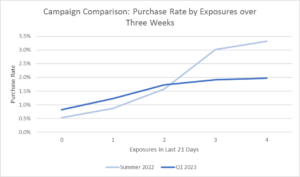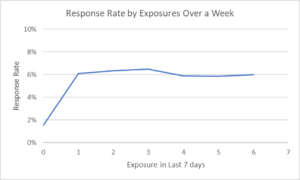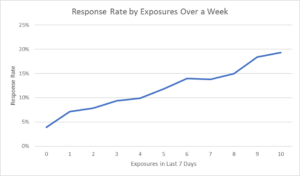Repeat, repeat and repeat again
Author: Shano Ahmad
Published: 14th February 2024
Frequency – is the rule of thumb for frequency still valid? A response to Michael Follett’s post
Two weeks ago, The Media Leader published an article by Michael Follett on the “three” rule of thumb for frequency. It was an insightful and thought-provoking post that highlighted the folk-wisdom that still exists in our industry. A key heuristic that was examined was whether the rule of thumb saying you need a 3+ exposure for a creative is still relevant today (or was it ever relevant) or maybe brands need to focus on reach and aim at a 1+ frequency.
Inspired by Follet’s exploration, we thought we’d use our Single Source data to scrutinize the validity of this rule of thumb. Our analysis revealed a nuanced reality: we saw that there is no ‘rule of thumb’ for advertising frequency and different campaigns have distinct behavior, resulting in tailored frequency strategies.
Below we have 3 examples of campaigns that have different frequency requirements:
A CPG Brand

The above graph shows two campaigns within the same Consumer Packaged Goods (CPG) brand. While the summer 2022 campaign experienced a significant response rate surge at the 3+ exposure mark, the Q1 2023 counterpart encountered diminishing returns post the second exposure. This discrepancy underscores the variability in frequency requirements even within a single brand’s portfolio.
Hello Fresh Campaign

The second graph shows the frequency effect of the Hello Fresh campaign from September 2023 (shown above). In this case we can see a strong increase in site visits after the first exposure but subsequent exposures fail to help. In this example a 1+ strategy would be optimal.
ASDA campaign

And finally, when looking at one of ASDA’s campaigns from last year, we can see that additional exposures continue to improve the campaign results with very little diminishing returns – in this case, there is no need for a strict frequency cap.
Conclusion:
Our data shows that there is no one-fits-all rule of thumb that can be used to decide on the optimal frequency but rather each campaign has different requirements; based on the product, the creative, the strength of the brand and much more. Luckily, Single-Source data enables advertisers to ditch the rule of thumb and rely on hard data.
Methodology:
Our frequency methodology analyzes response rates across different frequency levels, providing a granular understanding of audience behavior. By charting the response probability with each incremental exposure, we unveil how your audience truly reacted to your campaign, to help better inform you for future ones.
In today’s evolving advertising landscape, flexibility and data-driven precision reign supreme. It’s time to bid farewell to antiquated rules of thumb and embrace the era of tailored, evidence-based frequency strategies.